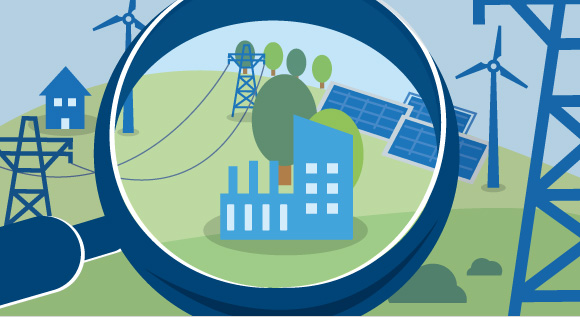What exactly is waste heat?
More than just a lot of hot air: a growing number of industrial companies are using waste heat to save money. In the following section, we explain how waste heat is generated and how it can be used in a way that turns a profit. We will also provide you with advice on how to obtain funding.
 © BMWi
© BMWiThis is what it’s all about: making efficient use of heat that is generated as a by-product
While your pizza is baking in the oven, the oven generates a lot of hot air. As soon as the door of the oven is opened, this hot air is released into the ambient environment, heating it up to a sizzling temperature. Fridges, too, continually release heat into the environment, thus ensuring that the contents inside remain cool. However, these processes are not limited to your kitchen; they also take place in industry, and this on a massive scale. Whether it is running engines, bringing metals to their melting point, compressing air or cooling down large rooms – throughout all sectors of industry we can find areas where large amounts of unnecessary heat are generated. The name for this kind of energy is waste heat.
Today, large amounts of waste heat from industrial processes are lost as the hot air and hot water that are generated as by-products are not used any further. However, companies can use these by-products to considerably cut their energy bills. This helps them to not only strengthen the competitiveness of their own business, but to also make an important contribution to the energy transition. In Germany, waste heat accounts for around two thirds of industry’s total energy consumption. Estimates suggest that around 125 terawatt hours could be saved at the process temperature level of 60 degrees or above. This translates into 5 billion EUR per year. However, even waste heat at temperatures of below 60 degrees can be used.
Heating, cooling, lighting: waste heat can be used for many purposes
So how can waste heat be used? Let’s take a look at the example of an energy plus house. This type of house uses the body heat from its residents and waste heat from electronic appliances such as stoves and fridges to heat up the rooms (to find out more about energy plus houses, please click here). The same principle can be applied to industrial companies. Depending on the temperature that the waste heat has, it can be used for a wide range of different purposes. Let us give you a few examples:
- Heat Recovery: Waste heat is fed back into the production process in which it was originally generated.
- Room heating and hot water: Waste heat can be used to heat up offices and manufacturing space. It can also be used to boil water. Large amounts of waste heat that is hotter than 90 degrees can be used outside the company and, for example, be fed into the heat network. To find out more about a Hamburg-based industrial company that will provide an entire city district with heat, please click here.
- Refrigeration: Even though it may sound like a contradiction, heat can also be used for cooling. So-called absorption refrigerators use heat energy in order to heat up a refrigerant (usually water) until it boils.
- Electricity: Waste heat can also be converted into electricity and can then be used in many different ways, for example for covering the electricity supply in one’s own production facilities.
The Federal Ministry for Economic Affairs and Energy is providing funding for both using and reducing waste heat
The Federal Ministry for Economic Affairs and Energy has several funding programmes in place under which funding is provided for measures that help to use or reduce waste heat. These include the waste heat energy efficiency programme, the programme for the promotion of highly-efficient cross-cutting technologies and the programme for energy-efficient and climate-friendly production processes. Funding is also available for obtaining expert advice.

